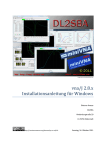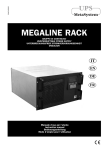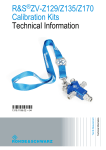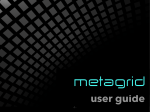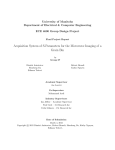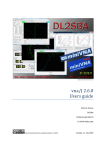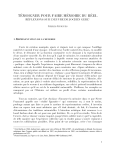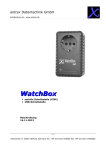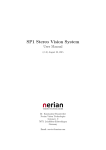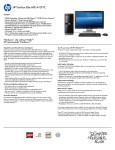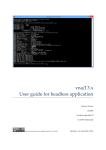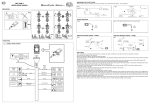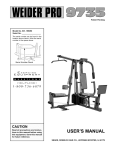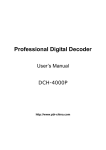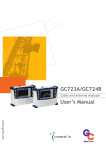Download Wireless M2M / IoT Cookbook
Transcript
First edition: Copyright © 2015 Harald Naumann, Neustadt Ludwig-Kaufholz-Weg 4, 31535 Neustadt, Germany E-mail: [email protected] Phone: +49-5032-8019985 The book has been finalized and will be further updated as necessary. All purchasers and sponsors will receive free PDF updates regularly. Any comments, requests, tips and suggestions related to the book or download zone are welcome. New chapters are marked with an update date and major changes are formatted with green text. This approach is meant to help owners of previous editions to identify the changes and additions more quickly. 2 Table of contents 1 Why Did I Write the IoT / M2M Cook 5 2 Fundamental considerations before starting the IoT / M2M project 7 3 Certifications and approvals 7 3.1 Examples for Radio approvals in EU and US 7 3.2 Examples for Radio approvals in US and Canada (PTCRB) 8 3.3 Examples for automotive related approvals in Europe 9 3.4 SAR - Specific Absorption Rate 10 4 Cellular data communication (GPRS, USSD, SMS, CSD, DTMF) 11 4.1 Voice communication 11 4.2 Modem / acoustic coupler / encryption 11 4.3 DTMF (Dual Tone Multi Frequency) 12 4.4 GPRS (General Packed Radio Service) 12 4.5 SMS 12 4.6 USSD (Unstructured Supplementary Service Data) 13 4.7 Comparison of power consumption (SMS, USSD and GPRS) 14 4.8 CSD (Circuit Switched Data) 15 5 Supply voltage 15 5.1 Power on timing and waiting 16 5.2 Cellular module in power save mode 16 5.3 Internal resistance of batteries and linear voltage transformers 16 5.4 Switched mode voltage regulator 18 5.5 Simulation of a switched power supplies with LT Spice 18 5.6 Capacitors at power supply and cellular module 20 5.7 Supply voltage for GNSS antenna 20 6 Antennas for IoT / M2M devices 20 6.1 Monopole and dipole antennas 20 6.2 Are you sure nothing will interfere with your embedded antenna? 21 6.3 Why do embedded chip or patch antennas have different resonant frequencies? 22 6.4 How will the ground plane affect your embedded antenna? 22 6.5 How to connect your embedded antenna with your wireless module 24 6.6 How to design an antenna matching circuit 26 6.7 Free of charge software to generate a matching circuit automatically 27 6.8 How to switch between an internal and external cellular or GNSS antenna inexpensively 27 6.9 Which GPS antenna should be used for a tracking device? 28 6.10 Which embedded antenna to select for a Bluetooth / GNSS application? 29 6.11 Dos and don’ts during embedded antenna design 32 6.12 Example: Embedded PCB antenna inside a vending machine 33 6.13 Example: Embedded antennas in Telematic device GPSauge IN1 v.2 of GPSoverIP 34 7 Simulation of an embedded GSM PCB track antenna 34 7.1 Definition of the antenna simulation project 34 7.2 Description of the inverted F antenna 35 7.3 3D model of the simulation 36 7.4 Optimization - determination of antenna shape 37 7.5 Typical requirements of a quad-band GSM antenna 37 7.6 Optimization of the quad-band antenna GSM antenna shape 39 7.7 Directional characteristics of the antenna for two GSM frequencies 39 7.8 Influence of the housing on antenna characteristics 41 7.9 Influence of the ground plane on antenna characteristics 42 7.10 Optimisation of the simulated antenna with matching circuit 44 7.11 Designing in the simulated antenna to a special GSM / GPS tracker 45 8 Components around the cellular module 47 8.1 SIM card 47 8.2 SIM card subscription 47 8.3 Low ESR capacitor 48 8.4 ESD protection 48 8.5 Loudspeaker and microphone 49 8.6 Firmware update for the final PCB 49 3 9 Examples of mistakes and errors during M2M development 49 9.1 Power down reset 49 9.2 SMS errors 49 9.3 CSD errors 50 9.4 IP connection errors 50 9.5 Analysis of several design mistakes in one M2M design 51 9.6 Analysis of mistakes of a PCB track antenna for GSM 52 9.7 Analysis of a GSM chip antenna on a small ground plane 53 9.8 Analysis of a Swiss GSM watch 54 9.9 Analysis of embedded LTE antenna in detail 54 10 Radiation noise, maximum spurious antenna radiation 55 10.1 Antenna radiation versus radiation noise 55 10.2 Conductive noise 57 10.3 Conductive noise transformed to radiated noise 57 10.4 Radiated noise transformed to conductive noise 57 10.5 Prevention against radiated noise 58 11 How to use a vector network analyser for IoT / M2M development 59 11.1 Quick Start Guide Vector Analyser MiniVNA Tiny 61 11.2 Explanation S11, VSWR, return loss, reflection coefficient and antenna bandwidth 11.3 Revealing the truth - four cellular antennas tested with MiniVNA 65 11.4 A comparison of three Vector Network Analysers 72 12 Testing your M2M device 78 12.1 TX power peaks by cellular module test mode 78 12.2 Pseudo load of 2 Ampere peak load with self-made function generator 78 12.3 TX power peaks with a GSM tester 79 12.4 Testing of the sensitivity 79 12.5 Testing radiated TX power 79 12.6 Where can you buy a cheap cellular tester? 80 12.7 Example of a measurement report from GSM test equipment 80 12.8 Ripple and peak voltage - visible on GSM test equipment 84 12.9 How to test a UMTS module on foreign band 85 12.10 Testing with UMTS testers 85 12.11 How to test an LTE module on foreign bands 86 12.12 Potential difficulties with LTE modules worldwide 87 12.13 Testing the GNSS module 87 12.14 Measurement of the cellular antenna in 3D 88 12.15 Summary of testing 89 13 AT Commands 89 13.1 AT commands during power on of your cellular module evaluation kit 89 13.2 ”Hello World” for GSM - AT commands to send a SMS 90 13.3 AT commands and logic loops to set up a communication channel 91 14 Project descriptions of IoT / M2M devices 91 14.1 Project description of a long-term tracking device 92 14.2 Project description of a flexible tracking device for bank notes 92 15 Thank you 93 4 63 1 Why Did I Write the IoT / M2M 95 I have worked in the Wireless M2M industry for more than a quarter of a century. Twenty-five years ago, we didn’t even have a word for “M2M” or “IoT”. We developed Machine to Machine devices without knowing that decades later these creations would be called “M2M devices”. Twenty-five years ago, the GSM network for wireless data communication did not exist. I took my first steps in wireless data communication with Frequency Shift Keying (FSK) on Private Mobile Radios (PMR). On PMRs we achieved communication speeds of 3600 bits per second. A little later we started using public analogue trunked radios. These trunked radio systems provided local terrestrial wireless networks on FSK. Years ago, the last public analogue trunked radio network in Germany was taken out of service. GSM jumped in with its Short Message Service (SMS) and Circuit Switched Data (CSD). CSD provided us 9600 bits per second. We could use SMS and CSD for straightforward countrywide data communication. Later on, GSM roaming offered us worldwide data communication. Today, GSM/GPRS is being gradually phased out and is being replaced by 3G and 4G technology. In the US, the cellular operator AT&T no longer accepts new M2M applications on GSM/GPRS. AT&T will only accept applications on 3G and 4G (UMTS, HSPA, LTE). Some people try to differentiate between M2M and IoT. Call it IoT or M2M - it does not matter. Applications for IoT or M2M often use the same wireless technology. IoT is the umbrella term for a number of subsets of wireless data communications. M2M is one of these subsets and maybe one of the oldest. Another subset of IoT is called Industry 4.0 or Industrial Internet of Things (IIoT). Just wait a while and a new buzz world will always come up. This IoT / M2M Cookbook describes how to develop a tracking device based on cellular and GNSS modules. You can create a telemetric device by ignoring the GNSS aspect. Typical devices without GNSS include cellular routers with Ethernet ports or a cellular to Wi-Fi bridge. Nevertheless, the navigation system for trucks described in this book already uses six different wireless technologies (2G, 3G, GNSS, Classic Bluetooth, Bluetooth Low Energy and NFC) with five different antennas within one enclosure. Cellular networks for GSM, HSPA and LTE are the popular Wireless Wide Area Networks (WWAN). However, in some regions we have WWAN over CDMA and WiMAX. Sometimes it is not easy to come up with the appropriate English word for the terms in this book. The common word for SMS in UK is "text message". In this book, we will consistently use the term “SMS”. A prepaid SIM card in UK is called a "Pay as you go SIM card". I will typically use the common words specified by ETSI - I will call it a prepaid SIM card. If I use the term “GSM module”, this will cover 3G and 4G modules as well, because the fall-back of UMTS, HSPA and LTE is still 2G (GSM/GPRS). GPS is fundamentally an incorrect term. The Global Positioning System (GPS) is just one out of several Global Navigation Satellite Systems (GNSS) that provide the functionality we refer to as “GPS”. We can currently access the Russian GNSS called Glonass. The Chinese GNSS is called Beidou. At some point we will be able to access the European GNSS called Galileo. The IoT / M2M Cookbook is intended to help developers of wireless applications save some time and perhaps provide some inspiring ideas. It is a book for makers and summarizes the collective experience across my different jobs. By leading the team of developers that is required to design a mobile GSM/GPS tracking device, I learned to think like a developer of an IoT / M2M device. In over fifteen years of working with manufacturing and distribution, I have repeatedly provided the same hints and recommendations to developers of wireless applications. The origin of this book was a 14-page application note written in July 2010. In May 2012, I made the decision to document the story that I deliver weekly to customers within a book. The goal of this book is to guide developers from the concept stage of an IoT / M2M device all the way to the final mass-produced product. This book will not provide introductory details such as how an inverted F antenna works. To explain those concepts, I will provide links to relevant supporting information. In any case, this book will provide you with information that is often omitted in the official radio module and antenna manufacturers’ documentation. This book shows an inverted F PCB antenna for GSM in detail. It explains how to redesign it with your own PCB and how to encapsulate the whole design in epoxy resin. It also explains how to integrate a chip or PCB antenna with coaxial cable. 5 Some power supply concepts including LT Spice modules for DC/DC regulators and load generator for the 2 Ampere peak currents are included in the book, too. It should be noted that the power down reset is still the main fault in designs with cellular modules. I hope you will enjoy reading the book and I hope it will save you some time as well. 6 2 Fundamental considerations before starting the IoT / M2M project Consider the design of an IoT/ M2M device in respect to its antenna and the necessary ground plane for that antenna. You could potentially save a lot of time and money by starting with the selection or design of the antenna and ground plane. However, you will have no chance of passing tests for Total Radiated Power (TRP) and Total Isotropic Sensitivity (TIS) limits if you select an antenna with poor efficiency. A smaller ground plane will significantly reduce TRP and TIS. The smaller corresponding PCB design may require more than four PCB layers. However, if multiple antennae for cellular, GNSS, Bluetooth, or Wi-Fi are in close proximity, as they are likely to interfere with one another. Keep in mind that components such as switched power supplies, displays and MCUs can create RF interference as well. If an IoT / M2M device fails the tests for TIS, the culprit is often the spurious emission from the PCB generated by other noisy components. If the spurious emission from your switched DC/DC regulator is high, then the RF signal level that you should plan on receiving has to be a few dB higher. The worst case would be if you were to create an undesired RF generator with a strong signal in the same frequency band as the one you are intending to receive. A cellular module is sensitive within in the range of -109 dBm while a GNSS module is sensitive in the range of -160 dBm. Your PCB design could mistakenly generate interference signals higher than -110 dBm or -160 dBm very easily. Even if you are not concerned with TRP and TIS requirements, a poor antenna design will drive a higher TX power level for the cellular module on the PCB. This defect will drain the battery faster and decrease the standby time of your M2M device. Ultimately customers will compare the battery life of your device to the familiar one in their pockets -- the mobile phone. If you have any concerns or questions, it may make sense to talk to third parties like the Field Application Engineer (FAE) of the local distributor or the FAE of the local test laboratory. Both of these engineers often offer some basic level of consulting free of charge. Budgeting for some additional consulting is often a good investment as well. A feasibility study or a working prototype with basic functions can save a lot of money and time. 3 Certifications and approvals The certifications and approvals in the table below represent an incomplete sample set. The certifications and limits are specific to individual IoT / M2M devices. The most important regulations, such as the R&TTE (now RED) in the EU and the FCC in the USA are listed below and explained further in later chapters. Please note that certifications and regulations are subject to change over time. The names may even change. The R&TTE (Radio and Telecommunications Terminal Equipment) has been renamed to RED (Radio Equipment Directive). The new name is not as commonly used right now so it will presently be more effective to use “R&TTE” in Internet searches for documentation related to those regulations. 3.1 Examples for Radio approvals in EU and US Testing Reference Type of testing Specification for region Europe R&TTE Directive Mobile Communication – EN 301 511 (RED) Article 3.2 Radiated Spurious Emission 2G Europe Europe Europe Europe Notes POS terminal, People tracker, Electricity meter Radio – Radio test EN 300 220 EN 300 220 Electricity meter (ISM – Transceiver (Tx, Rx class 3) 868 MHz) EMC – R&TTE acc. EN 301 EN 301 489-7 POS terminal, People 489-7 (GSM) – AC/DC powered tracker, Electricity meter EMC – R&TTE acc. EN 301 EN 301 489-3 Electricity meter (ISM 489-3 (SRD) – add on testing 868 MHz) R&TTE Directive (RED) Article 3.2 R&TTE Directive (RED) Article 3.1(b) R&TTE Directive (RED) Article 3.1(b) R&TTE Directive Electrical safety test EN 60950- EN 60950-1 (RED) Article 1, main powered device 3.1(a) 7 POS terminal, People tracker, Electricity meter 11.4 A comparison of three Vector Network Analysers Hopefully by now you have realised that a VNA (Vector Network Analyser) is a very useful instrument for the IoT / M2M hardware developer, because it helps you to measure and to check the most important part of the hardware design - the antenna and its transmission lines. It is one of those tools you did not know you were missing until you've got one. One that will save you a lot of time solving problems you are even not aware you have, but which can have a serious impact on the quality of your design, for example: unnecessarily high battery drain, malfunction, impaired range, etc. The VNA measures complex (transfer) impedances of 1-port (and depending on instrument also on 2-port networks). RF is all about “matching impedances” and “getting networks to work together”, so you can imagine that a VNA really can save you a lot of time and expense. Until recently VNAs cost a lot of money, starting at around 20,000 Euro, not the amount of money your manager would spend if you cannot promise in writing it will save him or her money. The good news is that those instruments are available now for well under 5,000 Euro. Suddenly a lot of RF-engineers have started regarding them as a tool they can really afford. Therefore, this chapter on usability is for those RF design engineers, especially engineers designing the bulk of today electronics: consumer electronics and industrial electronics in IoT and M2M. This chapter will compare VNAs for lab bench use going up to at least 3 GHz and covering the most used frequency bands in use for wireless IoT / M2M devices (e.g. NFC 13.42 MHz, GSM at 900/1800 MHz, UMTS at 2150 MHz, Bluetooth at 2450 MHz) in the price range under 5,000 Euro. 5,000 Euro because under that limit you often do not need to walk all the way up to the CEO’s office to get approval. (where it will be very difficult to explain to someone not involved with RF the value it provides) We have also included a VNA from Rohde & Schwarz (R&S) not because it is a very low cost unit (around 20,000 Euro), but because R&S is well established when it comes to RF-T&M gear. (In fact it is the low-cost R&S table top solution. Which shows low-cost is a relative term!) Comparision of three VNA: mRS: miniVNA-Tiny (approx. 430 Euro, 1 ... 3000 MHz) MegiQ: VNA-0440 (2,900 Euro, 400 ... 4000 MHz) Rohde & Schwarz: ZVL6 (20,000 Euro, 9 kHz ... 6000 MHz) Summary: mRS miniVNA Tiny: cheap, low quality; just useful for the radio amateur who has patience and expertise to interpret results. Phase information not very useful in VHF and UHF range. Rohde & Schwarz ZVL6: Professional quality, all round VNA, rather difficult to operate, very expensive. MegiQ VNA0440: Professional quality, for the RF designer, easy to use, low priced. 11.4.1 General overview MegiQ: For a few thousand Euro the MegiQ solution is a little beyond of the budget of most radio amateurs, but its performance makes is a very nice instrument for the professional. Also the frequency range, 400 MHz - 4 GHz is targeted for professional use in design of today’s consumer electronics. As a design engineer I am interested in the range of 400 - 4000 MHz and within this frequency band we found the unit to give results comparable to the Rohde & Schwarz unit at a fraction of the cost; really amazing. Operation is easy and straight forward, and it has a lot of unexpected extras. MiniVNA: The nice part is that you get coverage up from 1 MHz up to 3 GHz for very little money. But of course, for the price you cannot expect a lot. The MiniVNA looks and feels like a solution for the radio amateur. An advantage is that it is light and really tiny. Its measurements are sensitive to warming up so you need to switch it on and leave it for a while to reach a stable temperature. It is useful for measuring scalar parameters, like of Return Loss and SWR. It is incredibly noisy and not useful at all for any measurements where phase is involved, so if it comes to phase measurement it is not really a vector network analyser. Yes, it can display a Smith Chart, but as an engineer I would not dare to really develop circuits based on those noisy 72 measurements. It is really more of a kind of scalar network analyser than a vector network analyser. A spectrum analyser with a tracking generator is maybe the better solution. Rohde & Schwarz: If you go for general specification, the R&S is the best, but you can buy a nice car for that money. The frequency range is 9 KHz up to 6 GHz, it is a two port VNA. It is a one box solution with display and knobs on the front panel, but it is impractical to work with without an external mouse and keyboard. It “feels” like a German car, it is sturdy. But it is also heavy and bigger than the other solutions, which can be a disadvantage in some circumstances. For me, travelling around and is testing antennas in customers’ offices, this heavy machine is a non starter. The results are what you would expect from a 20.000 Euro machine Operation: Heavy to move around and front panel operation is cumbersome and very confusing. MegiQ: The instrument is controlled over USB by a desktop user interface that gives a good overview of measurement results, settings, saving/recalling. Operation is intuitive even with the many features available, such as stepping through bias voltages in multiple sweeps, automatic calculation of matching networks, etc. The MegiQ user interface is by far the most pleasurable to work with. The manual gives a good overview but you will hardly need it. The software runs on Windows XP, 7 and 8 and there are people using it on an Apple computer. Their web site says: “designed by and for RF-engineers”, and I got impression that the user interface has really been developed in close cooperation with actual RF-engineer users. It remembers where you left when closing the application, so when you start again you do not need to choose all those parameters again. The Session Manager is a very powerful but simple tool to group, save and recall your work: graphs, instrument settings, measurement data, calibration data, etc. I met the developer at an exhibition in Appledorn. They spent two hours training me and we measured some PCB antennas with coaxial cables together. Just to let you know, that the off-theshelf antennas resonated outside the GSM frequency range and showed a poor return loss as well. The MeqiQ VNA is designed by engineers that have to develop RF circuits and antennas daily. They developed a tool including accessories like the “sandbox” and help engineers with skills in electronics to design RF electronics. They help not just with a good VNA - they also help with documentation and accessories (sandbox) for self-education. If you combine it with the free of charge software Atyune, then you have a very powerful combination. With the MeqiQ VNA you measure the antenna, store the Touchtone file to your laptop, load it to Atyune and calculate the matching circuit with simple mouse clicks. MiniVNA: At first glance at the user interface you get an impression of the instrument, but if you look closer, it is not that obvious what the state of the instrument is. It does not look like one consistent program, but more like loose parts working together. For example if you want to see the Smith Chart, it opens in a different window and disappears to the background every time you hit the sweep button. And then you must save it using the “gif” button on the graph, this is a completely different procedure from that used to save the Return Loss graph -it is confusing. If, after performing an OSL calibration, you forget to hit the knob to actually use that calibration, you have to start over again; and calibration is really slow. The advantage is that the software is written in Java and will run without installation. The three helical antennas tested and listed in former chapter were measured with the miniVNA. The result is available on the cookbook server for download. For the scalar parameters VSWR and Return Loss the mniVNA shows a nice graph, but if you switch to Smith Chart, then you can see that the graph is jumping around wildly. If you then try to optimise a cellular PCB antenna shape multi resonant in GSM 850, 900, 1800, 1900 and UMTS 2150 then you will see that the Smith Chart cycles around several times, and on top the graph jumps around as well. Rohde & Schwarz: The instrument is normally controlled using the front panel although there is the possibility for remote control. To use it without a mouse and external USB keyboard is not easy. It runs under Windows, but the controls to access features like saving pictures (and where they actually go) are very difficult to find. Perhaps it is explained somewhere in the hundreds of pages of the user manual. And there are only two USB ports, so when using a keyboard and mouse, where does the memory stick to save the pictures go then... There are a lot of features, and the push buttons and context sensitive menus that pop up on the side of the screen are not very intuitive (and that's an understatement), so setting up the instrument before you can make a measurement is a tedious job. A seasoned RF engineer had to ask a 73 colleague who used the instrument daily for clues on how to operate it. I myself got lost. There are too many buttons on the front panel and there are too many pages to read. But of course once set up it works fine. The problem is that when you switch the instrument off, it behaves as if it suffered complete amnesia and next time you start it up, it comes back in an a completely different mode, other frequencies, etc. I assume there must be a setting for the defaults somewhere, but I could not find it. The transmission line and the antenna in a IoT / M2M device are the most important part, but the time you spend to get a VNA up and running has to be realistic. Yes it is a nice instrument, but for the price it costs you would expect a better user interface, one that is designed in cooperation with engineers who have to use the instrument daily. 11.4.2 Graphical presentation of results Besides the “technical specs”, graphical presentation of the measurement data is of importance. If you are doing a lot of measurements in a day you want a display that gives overview and in depth information at a glance. If you are only making a measurement every now and then, you want something easy to interpret. MegiQ: The MegiQ user interface is by far the best when it comes to graphical presentation of the results. You are completely free to arrange all kinds of graphical representations of the measurement data on the screen. And it is easy to do. And if you save and then recall a measurement, you can still rearrange the graphs and switch markers on and off. While making changes to the settings, the displayed measurement stays visible. The graphs are easily interpretable, even after you print them, since beside the markers there are labels along the trace lines. Similarly, after printing a Smith chart you can see what frequencies you are looking at along the trace. It is amazing that nobody else does this, not even the very expensive R&S. MiniVNA: You have one graph that displays the results. You can choose what parameter you want to display in that graph, except the Smith Chart. For this there is an extra graph, but that one disappears to the background every time you hit the sweep button. It was not easy to set multiple markers. The software for miniVNA is freeware by third party. Rohde & Schwarz: Without an external screen, the graphical presentation is a bit messy. The screen is too small to display multiple graphs in a useful way. 11.4.3 Save / recall MegiQ: When it comes to saving and recalling your work, setting etc, the MegiQ solution is the most powerful and at the same time the easiest to operate. It has a Session Manager where you group your settings, measurements, calibration tables in a very simple way and then save those groups in Session Files. For example, a file for each project, or a file for each kind of measurement. So you do not save a “picture” but the complete state of the instrument together with the measurements. From there you can of course choose to export the data in other formats to integrate into your report. But the big advantage is that when you want a different graph on the same data, or reposition the markers a week later, you can still do that (since you have the the complete dataset at hand and can load it back into the instrument) and then export it to your report. The MegiQ VNA was planned from the start to be connected to a laptop/PC and taking advantage of all the benefits that you can expect from a PC based VNA. Absolutely everything and any data including the settings are saved in one file. The measurement data, the markers, the calibration of the VNA are all stored together. If you power it off on Friday you just power it on and load the file on Monday and carry on without losing any time. MiniVNA: There are several ways to export measurements, but is is not in a structured way. So you can export e.g. to excel, csv, pdf, jpg, ... but are all separate files, so you have to remember what went where... Rohde & Schwarz: It is very unclear what you are saving and where you are saving it. If you look it up in the manual, you find out, but one month when I came back to use it I had forgotten how and where and had to look it up in the manual again. You can save the actual data and recall it, but it is cumbersome and you need to go through different menus to do it. Remember that the first Rohde & Schwarz VNAs were standalone machines without interface to a laptop, only later on did they get interfaces for floppy disks. 74 11.4.4 Exporting MegiQ: You have a print button that easily saves the measurement with a comment to EMF, which is a standard vector format, so you can scale it in your report without losing resolution. It uses the graphical representation you had put on the screen, so the the combined graphs and markers provide the complete overview you had in mind for the measurements. You can recall previous measurements, change the graphical representation, add markers, etc. and then again export the results. A method to export the graphs individually, is to use the right mouse button and copy & paste the individual graphs into another application, like Microsoft Word or Excel. Exporting the measurement data in TouchStone format is easy too, to import it in Excel or directly into your favourite RF simulation package. (there are three columns: freq, real and imaginary impedance) MiniVNA: You save the Return Loss graphs separately from the the Smith Charts. The latter can only be saved as a GIF. For the Return Loss graphs I had to rename the graphs in Windows every time, which is tedious. There is also the possibility to save the RL graph in a PDF, but you cannot combine the RL Graph with the Smith chart in one file for easy reporting. I export the data in Touchstone format and import it to Atyune. Atyune is much more handy because the developer of the software works daily with embedded antennas. Data can be exported in Touchtone (SP1), CSV, Excel or XML format. Rohde & Schwarz: Of course you can export in all kind of ways, but each is cumbersome: a lot of menus to go through, and hard to remember one month later. It is just not obvious. I'm happy I could get the graphs out of the instrument in order to use them in this report, but I had to ask someone who uses the instrument daily how to do it. For my daily job it is not just too expensive, it is not very user friendly as well. If you do not use it daily, then you will quickly forget how to use it. It does not look good if you struggle onto a customer site with a heavy piece of equipment and then spend hours reminding yourself how it works. 11.4.5 Some actual measurements circuit 1 Of course in the end it is very important that the instrument really does the job, so we compared two simple RCL circuits, on all three VNAs. The test will show graph of the Return Loss and a Smith chart. circuit 2 MiniVNA: When we see the Smith chart from the MiniVNA we see it is very noisy and it only gives an indication of the impedance at best. As a “bonus” you get spurious peaks, which are rather annoying: they are around the GPS frequency band. As with the R&S, (and many others) you cannot see from the plot which frequency you are looking at (only start and stop freq are clear). During the measurement you can put markers, but once the results are printed you can only guess. The Return Loss plot looks more useful, although it is rather “bumpy”. You do not see those bumps with the MegiQ and the R&S. The line should be smooth. MegiQ: A very clean Smith chart, very comparable to the data from the R&S box. In one glance you now see the advantage of the labels along the trace: you see where you are, also after saving it into a report! The Return Loss plot looks nice, and gives the same results as the R&S VNA. No artefacts (bumps) that should not be there. Rohde & Schwarz: As you would expect from R&S a clean Smith chart, comparable to the MegiQ graph. However it is not very easy to interpret the data after saving the picture, since we only know the start and stop frequency. Looking at one point on the trace, you must make a very rough guess at which frequency you are looking: There are no frequency labels along the trace. The Return Loss plot looks nice, and gives the same results as the MegiQ VNA. Let the graphs on the next pages speak for themselves... 75 11.4.6 Measuring LCR circuit 1 This is a capacitor in series with an inductor shunted with a resistor. MiniVNA, circuit 1 400 ... 3000MHz Note the graph is very noisy, and only gives an impression of impedance. MegiQ, circuit 1 400 ... 4000MHz R&S, circuit 1 400...4000MHz LCR circuit 1 (return loss graph) MiniVNA 1 ... 3000MHz MegiQ 400...4000MHz R&S 400...4000MHz 11.4.7 Measuring LCR circuit 2 This is a capacitor in parallel with an R and an L in series. MiniVNA, LCR circuit 2 MegiQ, LCR circuit 2 400...3000 MHz 400...4000 MHz Note the graph is very noisy, and only gives an impression of impedance. 76 R&S ZVL6, LCR circuit 2 400...4000 MHz LCR circuit 2 (return loss graph) MiniVNA 1...3000MHz (-12 ... 0 dB) MegiQ 400...4000MHz (-15 ... 0 dB) R&S 400...4000MHz (-15 ... 0 dB) 11.4.8 Helical antennas tested with two different Vector Network analysers MiniVNA: A very noisy and skipping Smith Chart. It will be difficult up to impossible to read impedance of the multi resonant antenna MeqiQ: A clear and good to read Smith Chart. The measurement of the helical GSM quad-band antenna at upper graphs were exported as Touchstone files (S1P) and imported to Atyune. In Atyune it is easy to set markers. With Atyune it is possible to set the colours and the thickness of the lines as well. 77 15 Thank you I would like to say thank you to all companies and people that sponsored and supported this book by text, graphics and schematic diagrams. David Perry Proofed the text of the book and helped me with the challenges of the English Language. MegiQ MegiQ helped with a free of charge personal training to me in Appeldorn. We measured several GSM PCB antennas together. On top MegiQ offers a discount for readers of the IoT / M2M Cookbook. In addition they measured some more antennas and the result is now a part of the book. Many thanks to Gert de Gooijer for answering all my questions by email and phone. http://www.megiq.com/ IK Elektronik IK helped with five working days for the simulation of the quad-band antenna in different conditions. Their graphics help a lot to explain how an embedded GSM antenna will work in standard, wrong and worst case conditions. www.ik-elektronik.com Triptec Triptec supported this book with the graphics about the power consumption during GPRS, SMS and USSD. They also helped with some tests and developments based on embedded cellular antennas. Many thanks to Wilhelm Oelers for the long term co-operation in the last few years, the content for the book and the content for several articles. http://www.triptec.de Atyune Atyune was so nice to give help with screen shots and with import and analysing of the simulated GSM antenna in this book as well. Many thanks to Devis Iellici for making such a nice freeware public and taking the time to explain the software by telephone. http://www.atyune.com SGS SGS helped with several proposals for the book cover of the IoT / M2M Cookbook. Specials thanks to Reimar Bührig, because he has not only looked after the book covers but has helped with very good training regarding radio approvals and certifications for my customers as well. http://www.sgsgroup.de/# Metasystem Metasystem helped with the schematic diagram of the pseudo load generator. Special thanks to Francesco Esposito because he helped with a short description how the generator works. http://metasystem.it antrax Datentechnik The CEO Wolfgang Schrader has been co-operating with me for more than 15 years. He developed several evaluation kits for different wireless modules for me. He used his VNA and helped with four tests reports of the antennas plus photos. http://www.antrax.de 95 Phasor Instruments Dr. Silvio Kühn CEO of Phasor Instruments gave me a 3 hour training lesson on a VNA. The lesson included measurement of 3 cellular antennas including export to S1P files and import to open source Qucs (Quite Universal Circuit Simulator). Silvio has developed and produced his own special VNA. http://www.phasor-instruments.de GPS over IP GPSoverIP helped with the final version of the book cover. Specials thanks to Tim Kilian, because he tweaked the photo and the colours of based on my wishes. http://www.gpsoverip.de 96















